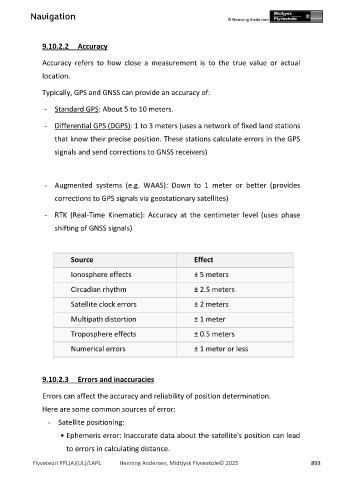Page 893 - PPL-engelsk 2025
P. 893
Navigation
9.10.2.2 Accuracy
Accuracy refers to how close a measurement is to the true value or actual
location.
Typically, GPS and GNSS can provide an accuracy of:
- Standard GPS: About 5 to 10 meters.
- Differential GPS (DGPS): 1 to 3 meters (uses a network of fixed land stations
that know their precise position. These stations calculate errors in the GPS
signals and send corrections to GNSS receivers)
- Augmented systems (e.g. WAAS): Down to 1 meter or better (provides
corrections to GPS signals via geostationary satellites)
- RTK (Real-Time Kinematic): Accuracy at the centimeter level (uses phase
shifting of GNSS signals)
Source Effect
Ionosphere effects ± 5 meters
Circadian rhythm ± 2.5 meters
Satellite clock errors ± 2 meters
Multipath distortion ± 1 meter
Troposphere effects ± 0.5 meters
Numerical errors ± 1 meter or less
9.10.2.3 Errors and inaccuracies
Errors can affect the accuracy and reliability of position determination.
Here are some common sources of error:
- Satellite positioning:
• Ephemeris error: Inaccurate data about the satellite's position can lead
to errors in calculating distance.
Flyveteori PPL(A)(UL)/LAPL Henning Andersen, Midtjysk Flyveskole© 2025 893

